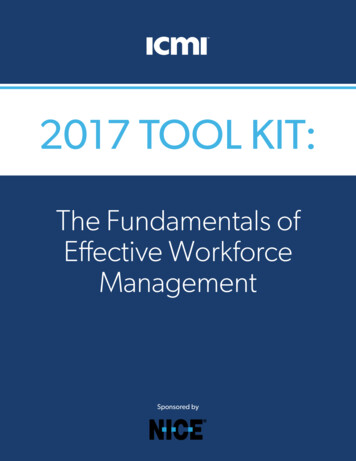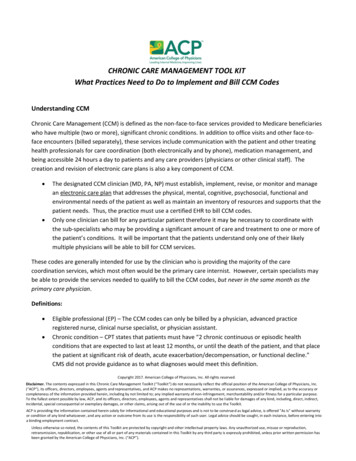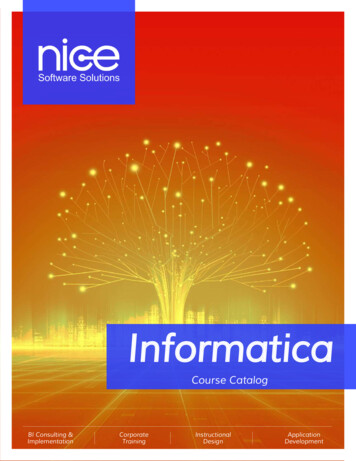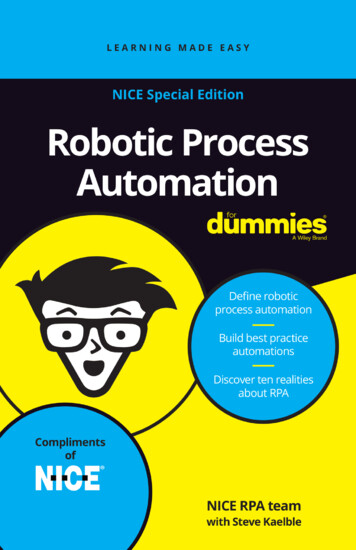
Transcription
2017 TOOL KIT:The Fundamentals ofEffective WorkforceManagementSponsored byICMI Tool Kit: The Fundamentals of Effective Workforce Management1
ICMI’s Planning & Management FrameworkAbout This Tool Kit:The latest workforce management research from ICMI and NICE reveals some interesting challengesand trends in today’s contact center. WFM remains a highly-manual function; Forecasting for non-voiceinteractions is minimal; And a frightening percentage of contact center’s don’t even measure forecastaccuracy. In light of these findings, ICMI and NICE have partnered on this ICMI Tool Kit to provide contactcenter leaders with some of the fundamental resources that they’ll need to develop an effective workforcemanagement program.In this toolkit, we’ll explore: How to use historical patterns and proportions to project volume for a future period of time Typical skills based routing errors and how to avoid them The importance of forecasting for back office activities and how to get started The hidden costs of manual intraday forecasting and the value of intraday automation ICMI and NICE’s research findings on the movement to cloud WFM and the challenges ofExcel-based forecastingICMI Tool Kit: The Fundamentals of Effective Workforce Management2
Step by Step: Breaking Down a ForecastKey Ideas: Breaking down a time series forecast involves using historical patterns andproportions to project volume for a future period of time. The process begins with long-term patters (e.g., month of year), and worksdown to specific half-hour increments. To the degree that patterns are a good indicator of future activity, these forecasts will bea good base on which to then blend in , 2541. D etermine operation days by counting the days thecontact center will be open.2. Calculate day-of-week index factors by dividingaverage day-of-week into the specific day’sproportionCurrent year’s contactsadd 12% (proportion)Forecasted annual contactsJanuary proportionJanuary calls 31Operation days – January1,847Average contacts per dayExample:Monday’s index factorMonday.210 .143 1.4692,713Monday’s contactsTuesday.170 .143 1.189x.05510:00 – 10:30 proportionWednesday.165 .143 1.154Thursday.165 .143 1.154Friday.150 .143 1.049Saturday.095 .143 .664Sunday.045 .143 .315x1.469149Forecasted contacts 10:00 – 10:30DOW Prop.Avg. Prop.Index 13141516171819202122232425262728293031ICMI Tool Kit: The Fundamentals of Effective Workforce Management* Proportions and Index Factor are explained on thefollowing page.3
Step by Step: Breaking Down a ForecastThe Step by Step Process:1.2. btain the number of calls received in the past 12 months.O(720,000 in example) Multiply the year’s calls by 1.12 to reflect 12 percent expected growth. Factoring in growth atthis level assumes that transactions will increase proportionally to the previous year’s patterns.(If your center has a targeted growth number, substitute that percentage.)If your growth instead will be concentrated around marketing campaigns or other events thatdon’t necessarily happen at the same time from year to year, factor it in at a more specific level,such as monthly or weekly.3. Multiply the estimated calls in the year by January’s proportion, (7.1% in example). Thispercentage comes from history and is the typical proportion of the year’s contacts receivedin January.4. Divide the number of operation days in the month into the estimated monthly contacts.This yields average contacts per day. In the above example, the center is open every dayof the month.5. djust average contacts per day, using the appropriate daily index factor. The index factorAgives the proportion of the week’s contacts that typically arrive each day. In the example,Monday normally gets 21 percent of the week’s traffic, Tuesday gets 17%, and so forth.The next column reflects the proportion of a week that an operational day represents. Forexample, for a center that is open seven days a week, each day is one-seventh or 14.3 percentof a week. For a center that is open five days a week, each day is one-fifth, or 20 percent of aweek, etc.The final column is the result of dividing the first column by the second column. These indexfactors are then multiplied against the average contacts per day to estimate traffic by the specificday of week. In the example, Monday’s index factor, 1.469, is multiplied against 1,847.6. he final step is to multiply the predicted contacts for each day of the week by each halfThour’s proportion. In the example, the half hour from 10:00 to 10:30 is projected to receive149 contacts.ICMI Tool Kit: The Fundamentals of Effective Workforce Management4
Avoiding the Common Problems ofSkills-based RoutingSkills-based routing is supposed to be the perfect answer to the challenge of getting the right contact tothe right place at the right time. But in many cases, skills-based routing creates difficult new problems thattemper or obviate the potential benefits: forecasting challenges, complex staffing puzzles and volatileservice levels.The top five problems that hamper good results and corresponding antidotesare summarized below:1. Rostered staff factor (shrinkage) issues:There are many things that can keep agents from answering contacts. With necessary skillsunavailable, contacts end up with secondary or tertiary alternatives, sending a ripple effectthrough the process that can misappropriate staff and send service level and quality plunging. Ifthere are times in the day that service level is volatile for some contacts, this issue is a likely culprit.There’s no substitute for realistically planning and budgeting for the things that keep agents fromanswer contacts.Solution:Spend the time necessary to routinely and realistically anticipate and plan for the activities thatkeep agents from answering contacts, by time of day and by skill set.2. Not forecasting accurately at the skill level:The queuing formulas and simulation models available for calculating required staff are only asgood as the accuracy of input they are analyzing. To anticipate staffing needs, you first need toknow how many customers with a broken-widget you’re going to get between 9:00 – 9:30. Theinability to forecast accurately at the skill level is the Achilles’ heel of even the most powerfulsimulation programs now available.Solution:Invest the time necessary to forecast contact load for each mix of contacts requiring unique skillsets (e.g. French speaking calls for Service, French speaking calls for Support, etc.) Access theaccuracy of forecasted contact load vs. actual; if it is routinely off by more than 5 percent to 10percent by half hour, consider combining skills to form more manageable groups.ICMI Tool Kit: The Fundamentals of Effective Workforce Management5
Avoiding the Common Problems ofSkills-based Routing3. Not calculating base staff requirements accurately:Skills-based routing generally requires computer simulation, which can test a wide range ofvariables and assumptions before actually implementing changes.Solution:Invest in a simulator, and spend the time necessary to run a wide range of scenarios to assessyour current capacity capabilities and requirements. When evaluating the market leading WFMsolutions, assess their ability to provide simulations that exactly match routing rules.4. Poor assumptions/rationale:In general, skills-based routing works best in environments that require many skills and havemany possible combinations of skill sets. Help desks handling a wide variety of complex issuesand contact centers handling many languages are common examples. Skills-based routing canalso help to quickly integrate new agents by initially routing only simple contacts or contacts of apredefined nature to them. What skills-based routing can’t do is compensate for poor planning,inadequate training or poorly designed information systems, Remember, the core assumption of acontact center is pooled groups, where cross-trained agents are equipped to share the workload.All things equal, pooled environments are more efficient than those with specialized groups.Solution:Create an environment that is as pooled as possible. This requires an incessant effort to hire theright people, improve training, improve information systems and reduce staff turnover. In otherwords, go as far as possible toward obviating the need for skills-based routing.5. No skills-based routing manager/coordinator:Even small contact centers have learned through tough, practical experience that it takes a fulltime person to keep skills-based routing running smoothly. Projecting requirements, assessingcurrent capabilities, updating system programming and adjusting staffing plans and schedulesto accommodate evolving circumstances are ongoing activities. Without such a position,organizations can struggle with matching skillsets to volume demands, and may find that somechannels are wildly overstaffed while others are grossly understaffed. Additionally, organizationswithout a designated skills-based routing owner often lack a throughly structured and effectiveprocess for managing skills.Solution:Create a position for managing skills-based routing. Equip this person or team with the tools,information and authority necessary to predict requirements, make necessary changes to systemprogramming and staffing plans, and advise on future requirements.ICMI Tool Kit: The Fundamentals of Effective Workforce Management6
The Do’s and Don’ts of Back Office ForecastingThe back office is a critical function of most organizations and is often deeply interrelated to the contactcenter. Despite this connection, however, many organizations do not apply the same principals of “frontoffice” planning and forecasting to the repetitive and predictable tasks of the back office.Here are some practical do’s and don’ts for applying forecasting principals tothe back office.DO: Establish metrics to measure the workload and distribution patterns. Accurate data is the foundationof a successful forecast!DON’T: Accept a lack of transparency into the areas encompassed by “back office”. Defining these areasand understanding their scope of work is critical.DO: Find a way to capture every single back-office transaction. This may require self-recording at first, butideally you’d integrate a system that’s guaranteed to track and support every process.DON’T: Treat back office interactions exactly like their contact center counterparts. There are several keydifferences between calls and back office tasks. Back office tasks are commonly divided into multi-owner (skill) relationships. There is no possibility of “abandonment” with back office tasks. Agents can handle multiple back office tasks at a time. Back office tasks may carry over between multiple shifts.DO: Involve back office employees into the process of planning for and evolving the back officeforecasting process. Change is rarely adopted when it comes as a mandate from the top down.DON’T: Blame the existing back office team for shortcomings or inefficiencies in their back office solution.Get them involved in evaluating the root cause of problems and evaluating the best path (and solution)forward.DO: Develop and align business KPIs that align with back office staffing plans, process improvements, andoperational goals.ICMI Tool Kit: The Fundamentals of Effective Workforce Management7
Intraday Forecasting:Is the Effort Worth the Outcome?According to ICMI’s latest research, intraday forecasting and schedule adjustments happen in 29% ofcontact centers. For 71 percent of those organizations, it’s a manual process, which forces the contactcenters to weigh the return of intraday against the effort involved in creating the forecast.Contact centers aren’t just creating more work for themselves by making these manual changes to skillassignments within the ACD throughout the day – they’re compounding and further complicating theproblem.The accuracy of future forecasts depends on the integrity of the data that’s provided and, all too often,the manual changes to intraday staffing aren’t tracked accurately and disguise the root cause data that’snecessary to improve the accuracy of future forecasts. Continuing to treat the symptoms of an inaccurateforecast, rather than addressing the root causes, will only cause further damage to service levels and theorganizations ability to achieve key performance indicators. In fact, these data inconsistencies will onlylead to further gaps in future forecasts and can create even more manual work to adjust future forecastedskill requirements.The solution here is two-fold:1. D eploy automation and technology assisted functions wherever possible in your real-timemanagement efforts. Not only does it reduce or eliminate the manual work, but it alsoaccurately tracks the changes and modifications to skill assignments to ensure that they’reaccounted for in future forecasts.2. C reate short-term forecasts to increase the accuracy of your schedule. This approach willreduce, or prevent entirely, the need to make manual adjustments to agent skills because ofinaccurate forecasting.With the right tools and resources, intraday forecasts are easy to produce and are often quite accurate.Typically, short-term forecasts are more accurate than long-term forecasts. More importantly, whenautomated, intraday forecasts can maximize resources while reducing the costs and lost productivityassociated with manually forecasting.ICMI Tool Kit: The Fundamentals of Effective Workforce Management8
Intraday Forecasting:Is the Effort Worth the Outcome?Intraday Forecasting:402Calls received by 10:30 a.m. .18Usual proportion of calls by 10:30 a.m.2,233Revised forecast for dayx.0663:30 – 4:00 p.m. proportion147Intraday forecast for 3:30 – 4:00 p.m.The approach works like this: At some point in the morning, say just after 10:30 a.m., reports indicate 402calls have been received so far. Divide the usual proportion of the day’s calls that would be expected by10:30, 18 percent in this example, into 402. (Eighteen percent came from looking at traffic patterns onprevious days and calculating half-hourly proportions.) If the trend continues, 2,233 calls can be expectedfor the day.Next, you can break the revised daily forecast down into the remaining half hours by multiplying historicalhalf-hourly proportions by 2,233. For example, since 6.6 percent of a day’s calls would be expectedbetween 3:30 and 4:00 p.m., 147 calls can be expected during that half hour.The assumption behind intraday forecasting is that the morning will set the tone for the afternoon.However, this will be a bad assumption for a utility getting swamped with calls in the morning due to amajor power outage. When the outage is fixed, the calls will call away. In many cases, though, intradayforecasting is a useful and accurate tool. What’s important is that you recognize its value and can effectivelyforecast and staff for the intraday changes.ICMI Tool Kit: The Fundamentals of Effective Workforce Management9
Is WFM Moving to the Cloud?15% of contact centers today use cloud-based WFMBy size:Under 50 Agents: 12.5%50 – 500: 36%500 : 85%22%36%not utilizing cloud plan to movewithin the next 6 – 12 months, whileare still undecided.Who’s planning to move – by current solutionOn-premise:Excel/Spreadsheet:No solution:36%64%19%within 6monthswithin 6monthswithin 6-12monthsThe most important scheduling capabilities? Benefits of moving tothe cloud:1. Guaranteed systemuptime (84% — Very orExtremely Important)2. educe time toRdeployment (70%— Very or ExtremelyImportant)3. hift of costs fromScapital to operatingexpenses (68% — Veryor Extremely Important)4. bility to add/removeAlicenses month-tomonth (59% — Very orExtremely Important)Schedule optimally across multiple sites (50%)Optimize use of employees’ multiple skills (57%)ICMI Tool Kit: The Fundamentals of Effective Workforce Management10
The Dangers and Downfalls ofExcel-Based ForecastsExcel is a commonplace tool in contactcenters under 500 seats.(It’s the tool used inapproximately 1/3 ofthose contact centers)1 in 4 contact centersare making updatesin Excel more thanonce per week.A majority of contacts believe that WFM is extremely important to their organization. Is itreally okay to leave something that important prone to so much manual work and potentialfor error?The most manual process:1. Agent schedule adjustmentsWhich contributes to some veryreal scheduling challenges:2. Updating changes to agent skills orchannels based on volume1. Managing and responding to real-timechanges in workload/staff availability3. Reporting2. Ineffective scheduling tools andresources4. Building of volume forecasting models5. Agent schedule creation3. Lack of time/resources to explore newscheduling scenariosNone of these manual process or challenges will helporganizations achieve their number one goal right now:Delivering improved service at same or lowered costsSuddenly it’s not such a surprise that, of theorganizations planning to move to the cloud,67% will be leaving their spreadsheets behind!ICMI Tool Kit: The Fundamentals of Effective Workforce Management11
About ICMIThe International Customer Management Institute (ICMI) is the leading global provider of comprehensiveresources for customer management professionals—from frontline agents to executives—who wish toimprove customer experiences and increase efficiencies at every level of the contact center. Since 1985,ICMI has helped more than 50,000 organizations in 167 countries through training, events, consulting,and informational resources. ICMI’s experienced and dedicated team of industry insiders, trainers, andconsultants are committed to helping you raise the strategic value of your contact center, optimize youroperations and improve your customer service. ICMI is a part of UBM plc (ubm.com), a global events-ledmarketing services and communications company.About NICENICE, the vanguard for workforce management innovation, recognizes the constantly changing demandsfacing the modern organization. Our solutions offer a robust feature set designed to meet the up-to-theminute industry developments discussed in this report, including advanced task automation in backoffice WFM, branch solutions for brick-and-mortar locations, and employee engagement resources.NICE’s automated decisioning tools have been custom-built to reduce time spent on manual intradaymanagement processes and improve work-life balance for agents through self-managed schedulingand personal empowerment. We invite our current customers and anyone interested in optimizing theirworkforce to take a closer look at NICE’s offerings, including NICE WFM, NICE EVOLVE WFM andNICE EVOLVE Branch WFM, to find the solution that best fits their needs.ICMI Tool Kit: The Fundamentals of Effective Workforce Management12
ICMI Tool Kit: The Fundamentals of Efiective Workforce Management 4 The Step by Step Process: 1. Obtain the number of calls received in the past 12 months. (720,000 in example) 2. Multiply the ye











